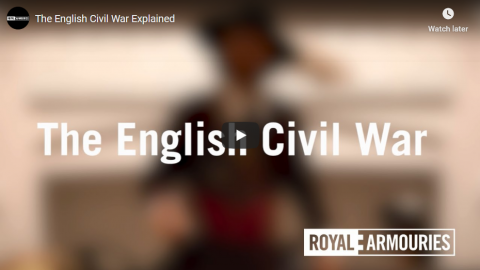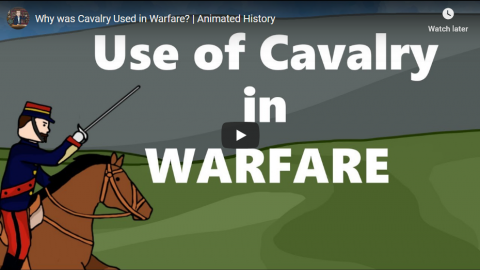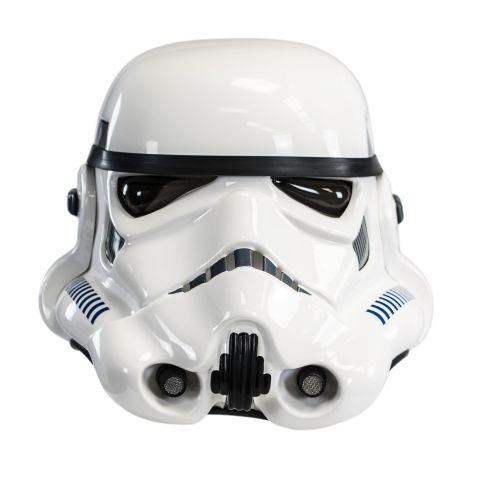Royal Armouries
Published 20 Dec 2017The Royal Armouries’ English Civil War collection boasts an array of infantry and cavalry arms and armour from the 1640s. Delve into this turbulent historical period with our resident Royalist, David.
Where to find us:
⚔Website: https://royalarmouries.org/home
⚔Blog: https://blog.royalarmouries.org/
⚔Twitter: https://twitter.com/Royal_ArmouriesThe Royal Armouries is the United Kingdom’s national collection of arms and armour. On this channel, discover what goes on behind the scenes at the museum and to see our collection come to life. From combat demonstrations to jousting coverage to behind the scenes tours with our curators, we’ve got it covered.
Have a question about arms and armour? Feel free to leave us a comment and we’ll do our best to answer it.
December 14, 2019
The English Civil War Explained
November 29, 2019
Why was Cavalry Used in Warfare? | Animated History
The Armchair Historian
Published 11 Jan 2018Why was Cavalry used in warfare?
Our Website: https://www.thearmchairhistorian.com/
Our Twitter:
@ArmchairHistSources: https://en.wikipedia.org/wiki/Horses_…
http://www.napolun.com/mirror/napoleo…
http://napoleonistyka.atspace.com/cav…
https://en.wikipedia.org/wiki/Cavalry…
https://ehistory.osu.edu/exhibitions/…
http://www.cincinnaticwrt.org/data/cc…
http://www.napolun.com/mirror/web2.ai…Music: Music: Antonio Salieri: “Twenty six variations on La Folia de Spagna“
From the comments:
The Armchair Historian
1 year agoSo two things….
1. A lot of people are saying the video is an oversimplification. You’re exactly right, this is a prelude of a series I’ll be doing covering all types of cavalry from all different eras, as well as tanks. I’ll be covering mainly the abstract, and the concepts, and less of all the specific numbers and statistics. This video is to act as an intro.
2. A lot of people are saying cavalry and tanks aren’t the same. You’re right again, but here’s what I meant in the video. The tank replaced the cavalry, and still fulfills the abstract usage of cavalry, as a decisive shock unit. You don’t have many of them, they’re more expensive, and they hit harder than their counterparts, infantry, and artillery. Of course tanks are not used in the same way cavalry was in warfare, but as cavalry left they were replaced by armor. In fact, many people tried to use tanks just like cavalry, but it didn’t work. It took up until the end of WW2 for most generals to realize this.
Hope that clears some stuff up,
Griff
To give an example of his second point, the British use of “cruiser” tanks in the Western Desert campaign of World War 2 typified the “it’s just an armoured horse” view of tanks. Disproportional British tank losses to German anti-tank guns was the usual result.
May 20, 2019
The Evolution Of Knightly Armour – 1066 – 1485
Metatron
Published on 16 May 2017A video full of details which took over 30 hours in the making. I hope you like it and you find the info in it useful 😀
Armour (spelled armor in the US) is a protective covering that is used to prevent damage from being inflicted to an object, individual, or vehicle by weapons or projectiles, usually during combat, or from damage caused by a potentially dangerous environment or action. The word “armour” began to appear in the Middle Ages as a derivative of Old French. It is dated from 1297 as a “mail, defensive covering worn in combat”. The word originates from the Old French armure, itself derived from the Latin armatura meaning “arms and/or equipment”, with the root armare meaning “arms or gear”.
Armour has been used throughout recorded history. It has been made from a variety of materials, beginning with rudimentary leather protection and evolving through mail and metal plate into today’s modern composites.
Significant factors in the development of armour include the economic and technological necessities of its production. For instance, plate armour first appeared in Medieval Europe when water-powered trip hammers made the formation of plates faster and cheaper.Well-known armour types in European history include the lorica hamata, lorica squamata, and lorica segmentata of the Roman legions, the mail hauberk of the early medieval age, and the full steel plate harness worn by later medieval and renaissance knights, and breast and back plates worn by heavy cavalry in several European countries until the first year of World War I (1914–15). The samurai warriors of feudal Japan utilised many types of armour for hundreds of years up to the 19th century.
Plate armour became cheaper than mail by the 15th century as it required less labour, labour that had become more expensive after the Black Death, though it did require larger furnaces to produce larger blooms. Mail continued to be used to protect those joints which could not be adequately protected by plate.
The small skull cap evolved into a bigger helmet, the bascinet. Several new forms of fully enclosed helmets were introduced in the late 14th century.By about 1400 the full plate armour had been developed in armouries of Lombardy. Heavy cavalry dominated the battlefield for centuries in part because of their armour.
Probably the most recognised style of armour in the World became the plate armour associated with the knights of the European Late Middle Ages.
March 26, 2019
Donning hoplite armour
Lindybeige
Published on 28 Sep 2016How long does it take a hoplite to get ready for action? Watch one incompetent one time himself as he dons his panoply.
Support me on Patreon: https://www.patreon.com/Lindybeige
More weapons and armour videos here: https://www.youtube.com/playlist?list…
Some game systems have rules on how long it takes to put on armour. Here I give you some practical hints as to how long it actually takes. Yes, the sword and shield are just mock-ups, but the time it takes to take them up is probably about the same as the real thing.
Was this really shot in ancient Greece? No, it was a park in Gosforth, near a primary school and with aircraft flying overhead and a breeze just strong enough to create constant rustling of leaves and occasional wind noise on the microphones.
Buy the music – the music played at the end of my videos is now available here: https://lindybeige.bandcamp.com/track…
Lindybeige: a channel of archaeology, ancient and medieval warfare, rants, swing dance, travelogues, evolution, and whatever else occurs to me to make.▼ Follow me…
Twitter: https://twitter.com/Lindybeige I may have some drivel to contribute to the Twittersphere, plus you get notice of uploads.
website: http://www.LloydianAspects.co.uk
June 1, 2018
Spiked armour
Lindybeige
Published on 11 Nov 2012In summary: no.
www.LloydianAspects.co.uk
April 28, 2018
How A Man Shall Be Armed: 14th Century
Royal Armouries
Published on 20 Feb 2017Discover how the introduction of plate armour changed the way knights of the 14th Century armed themselves for battle.
March 3, 2018
How A Man Shall Be Armed: 11th Century
Royal Armouries
Published on 20 Feb 2017Discover how a Norman knight of the 11th Century would be armed for battle with the finest equipment available.
October 26, 2017
How A Man Shall Be Armed: 15th Century
Royal Armouries
Published on 20 Feb 2017The 15th Century was the highpoint of the armourers craft, with knights across Europe taking to the field of battle in elaborate and almost impregnable suits of plate armour. Discover how a knight of the 15th Century would arm themselves for combat.
October 25, 2017
Crusader helmets
Lindybeige
Published on 4 Sep 2014Here I show you three common styles of crusader helmet, and I comment upon them.
Thanks to Dr David Tetard for the loan of his helmets. These particular ones were bought here:
www.getdressedforbattle.co.uk
http://www.kovexars.cz/index.php (HL 007 and 103)Lindybeige: a channel of archaeology, ancient and medieval warfare, rants, swing dance, travelogues, evolution, and whatever else occurs to me to make.
October 21, 2017
Can You Move in Armour?
Medievalists
Published on 30 Jun 2016“Moving in harness”, a short film by Daniel Jaquet, realised by Vincent Deluz. On display at the exhibition “Armatus Corpus” at the Military Museum, Castle of Morges, Switzerland – The issue of mobility in armour is addressed there with striking images of actual armour pieces to demonstrate the range of movement allowed when worn. Today, our contribution follows the same goals, but with other technological means and approach. In this video we have put in images the deeds of the famous knight Jean le Maingre, known as Boucicaut, which were put in writing in the early 15th century. It includes a well-known passage where his training in armour is described in some details, outlining what you could actually do in a late medieval armour.
Learn more at http://www.medievalists.net/2016/07/can-you-move-in-armour-an-experiment-in-mythbusting/
May 31, 2017
Stormtrooper gear
In The Register, Gavin Clarke talks about “inexpensive” replicas of the original Star Wars stormtrooper helmets and other gear:
Two years ago, the helmet of an Empire Strikes Back stormtrooper fetched $120,000 (£92,736) at US auction.
An Imperial TIE fighter pilot’s helmet, said to be one of just 12 made for A New Hope, went the following year for £180,000 ($233,244) – something the BBC’s Antiques Roadshow presenter Fiona Bruce dismissed as a “piece of plastic”.
Big money indeed, but the record to date for stormtroopers, the most widely recognised symbol of the Empire, is held by A New Hope sandtrooper helmet, named the Stop That Ship Helmet for the scene it briefly appeared in – the Millennium Falcon blasting out of Mos Eisley under fire. That helmet sold at auction in April for $190,000 (£145,675) in the US.
Yes, four decades after A New Hope debuted in the US – 25 May, 1977 – props built for just £20 a pop are fetching the price of a three-bed semi in the West Midlands.
What’s helping drive up the price is scarcity: just 50 stormtrooper uniforms were made for A New Hope. Those that survived the shoot now reside in private collections.
[…]
So, where does a 30-something who wants a piece of the legend go? Not the mass market of sub-£1,000 suits that targets the fancy dresser.
No, they tap a cottage industry of British specialists – Ainsworth’s Shepperton Design Studios, Edwards’ CfO, and RS Prop Masters in the UK.
This trio is busy vacuum forming sheets of white ABS plastic using curved moulds to a 1.5mm thickness, cutting out and assembling around 30 pieces per suit, making straps, body suits, eyepieces, mics, boots and blasters. Prices run from £1,200 – around $1,550.
And in case you were wondering, there are few concessions on size or girth. The original stormtrooper was 5ft 10in and 110lbs. He remains so. The most you can expect is a little extra plastic around the overlapping at the edges if you’re a little large for a stormtrooper.
March 26, 2017
Comparing WW1 Helmet Designs I OUT OF THE TRENCHES
Published on 25 Mar 2017
Start Your Free Trial For The Great Courses Plus*: https://www.thegreatcoursesplus.com/special-offer?utm_source=US_Influencer&utm_medium=InfluencerYouTube&utm_campaign=143317
It’s time for the Chair of Wisdom again and this week Indy compares World War 1 helmet designs and we talk about the discrimination of Germans in the US during WW1.
April 26, 2016
Body Armor – Fortress Design – Belgian Armoured Car Division I OUT OF THE TRENCHES
Published on 25 Apr 2016
It’s Chair of Wisdom time again and this week we talk about the experiments with body armor of World War 1, fortress design and the Belgian Armoured Car Division.
January 20, 2016
German Uniforms of World War 1 I THE GREAT WAR Special
Published on 18 Jan 2016
From the iconic Pickelhaube to the almost legendary Stahlhelm and the field grey colour, German military uniforms of World War 1 are instantly recognisable. But there is more to them than just the spiky leather helmet that was often used in enemy propaganda. In our new special episode we are talking about the details of the German uniforms in the First World War.
January 14, 2016
QotD: The introduction of the steel helmet for British troops in WW1
They were not, as The Times correspondent claims, there to protect the wearer from rifle or machine-gun bullets. Indeed, as I understand it, even modern helmets are not always proof against high-velocity rounds. What they were there to do was to protect soldiers from shrapnel. Shrapnel, in case you didn’t already know, is the collective noun for steel balls being expelled from an air-bursting (or Shrapnel) shell. It was a huge killer in the First World War and the steel helmet did a great deal to save lives.
One of the good things about the Brodie helmet – as it sometimes known – is that it had an internal harness. This meant that if the helmet was dented the dent was not necessarily reproduced in the wearer’s skull.
On the shape, however, with a wide brim and no neck protection, I have always been in two minds. On the one hand, if the threat is from above you would have thought the shape was a good thing as it covers a large part of the wearer’s body. It is also easy to make. On the other hand, British helmets over the last 100 years have progressively given more neck protection which sounds like the British Army’s way of saying they got it wrong.
By the way, in my limited experience both steel and more modern Kevlar helmets are a pain in the arse to wear. You either can’t see anything from a prone position or you can’t see anything from a prone position and get a headache.
Patrick Crozier, “The British army gets steel helmets”, Samizdata, 2015-12-02.






